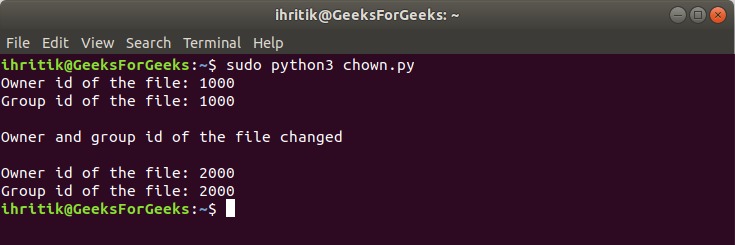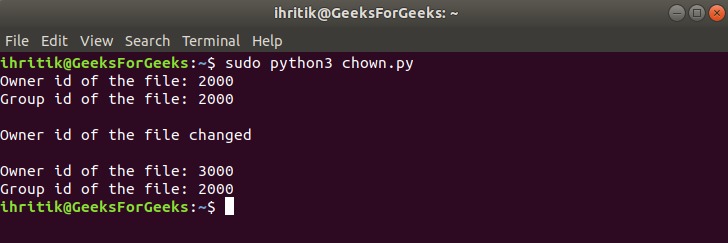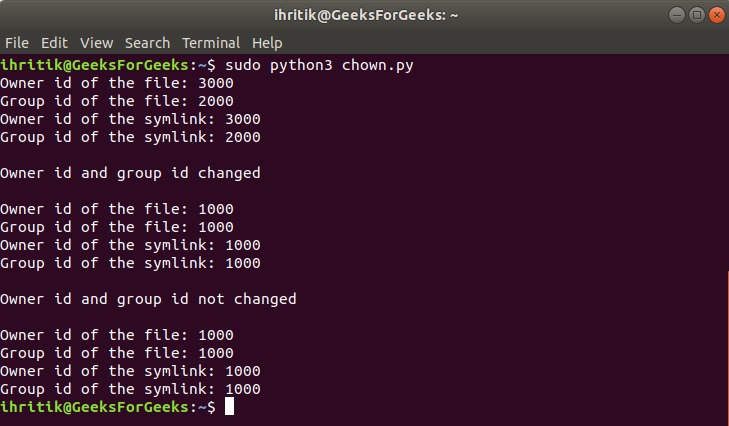Python中的OS模块提供了与操作系统进行交互的函数。操作系统属于Python的标准实用程序模块。该模块提供了使用依赖于操作系统的函数的便携式方法。
如果文件名和路径无效或无法访问,或者具有正确类型但操作系统不接受的其他参数,则os模块中的所有函数都会引发OSError。
os.chown()Python中的方法用于将指定路径的所有者和组ID更改为指定的数字所有者ID(UID)和组ID(GID)。
注意: os.chown()该方法仅在UNIX平台上可用,并且该方法的函数通常仅对超级用户或特权用户可用。
用法: os.chown(path, uid, gid, *, dir_fd = None, follow_symlinks = True)
参数:
路径:表示要设置其uid和gid的文件的文件描述符
uid:一个整数值,表示要为路径设置的所有者ID。
id:一个整数值,表示要为路径设置的组ID。要使任何一个ID保持不变,请将其设置为-1。
dir_fd(可选):引用目录的文件描述符。此参数的默认值为“无”。
follow_symlinks(可选):此参数的默认值为True。如果我们不希望os.chown()方法遵循符号链接,则可以将其设置为False。如果为False,则方法将对符号链接本身进行操作,而不是对链接指向的文件进行操作。
注意:参数列表中的“ *”表示以下所有参数(在本例中为“ dir_fd”和“ follow_symlinks”)均为keyword-only参数,可以使用其名称(而不是位置参数)来提供。
返回类型:此方法不返回任何值。
# Python program to explain os.chown() method
# importing os module
import os
# File path
path = "./file.txt"
# Print the current owner id
# and group id of the
# specified file path
# os.stat() method will return a
# 'stat_result’ object of
# ‘os.stat_result’ class whose
# 'st_uid' and 'st_gid' attributes
# will represent owner id and group id
# of the file respectively
print("Owner id of the file:", os.stat(path).st_uid)
print("Group id of the file:", os.stat(path).st_gid)
# Change the owner id and
# the group id of the file
# using os.chown() method
uid = 2000
gid = 2000
os.chown(path, uid, gid)
print("\nOwner and group id of the file changed")
# Print the owner id
# and group id of the file
print("\nOwner id of the file:", os.stat(path).st_uid)
print("Group id of the file:", os.stat(path).st_gid) 输出:

# Python program to explain os.chown() method
# importing os module
import os
# File
path = "./file.txt"
# Print the current owner id
# and group id of the file
# os.stat() method will return a
# 'stat_result’ object of
# ‘os.stat_result’ class whose
# 'st_uid' and 'st_gid' attributes
# will represent owner id and group id
# of the file respectively
print("Owner id of the file:", os.stat(path).st_uid)
print("Group id of the file:", os.stat(path).st_gid)
# Change only owner id of
# the file and leave
# group id unchanged
# set id as -1 to leave
# it unchanged
uid = 3000
gid = -1
os.chown(path, uid, gid)
print("\nOwner id of the file changed")
# Print the owner id
# and group id of the file
print("\nOwner id of the file:", os.stat(path).st_uid)
print("Group id of the file:", os.stat(path).st_gid) 输出:

# Python program to explain os.chown() method
# importing os module
import os
# File path
path = "./file.txt"
# Creating a symlink
# of the above path
# using os.symlink() method
symlink = "./file(symlink).txt"
os.symlink(path, symlink)
# Print the current owner id
# and group id of the file
# as well as the symlink pointing
# to the above specified file path
print("Owner id of the file:", os.stat(path).st_uid)
print("Group id of the file:", os.stat(path).st_gid)
print("Owner id of the symlink:", os.stat(symlink).st_uid)
print("Group id of the symlink:", os.stat(symlink).st_gid)
# Change the owenership
# of the symlink pointing
# to the above file './file.txt'
uid = 1000
gid = 1000
os.chown(symlink, uid, gid)
print("\nOwner id and group id changed")
# Print the owner id
# and group id of the file
# as well as the symlink
print("\nOwner id of the file:", os.stat(path).st_uid)
print("Group id of the file:", os.stat(path).st_gid)
print("Owner id of the symlink:", os.stat(symlink).st_uid)
print("Group id of the symlink:", os.stat(symlink).st_gid)
# As os.chown() method
# follows symlink
# so, we can change the
# owner and group id
# through a symlink
# We can modify the follow_symlinks
# parameter if we do not
# want os.chown() method to
# follow symlink
# Change the owenership
# of the symlink pointing
# to the above file './file.txt'
uid = 4000
gid = 4000
os.chown(symlink, uid, gid, follow_symlinks = False)
print("\nOwner id and group id not changed")
# Print the owner id
# and group id of the file
# as well as the symlink
# pointing to it
print("\nOwner id of the file:", os.stat(path).st_uid)
print("Group id of the file:", os.stat(path).st_gid)
print("Owner id of the symlink:", os.stat(symlink).st_uid)
print("Group id of the symlink:", os.stat(symlink).st_gid)输出:

参考: https://docs.python.org/3/library/os.html
相关用法
- Python next()用法及代码示例
- Python os.dup()用法及代码示例
- Python set()用法及代码示例
- Python sympy.sec()用法及代码示例
- Python os.fchown()用法及代码示例
- Python sympy.gcd()用法及代码示例
- Python sys.setrecursionlimit()用法及代码示例
- Python sys.getdefaultencoding()用法及代码示例
- Python sys.getrecursionlimit()用法及代码示例
- Python sympy.Mul()用法及代码示例
- Python PIL Image.new()用法及代码示例
- Python os.unlink()用法及代码示例
- Python os.lchown()用法及代码示例
- Python sympy.lcm()用法及代码示例
注:本文由纯净天空筛选整理自ihritik大神的英文原创作品 Python | os.chown() method。非经特殊声明,原始代码版权归原作者所有,本译文未经允许或授权,请勿转载或复制。
